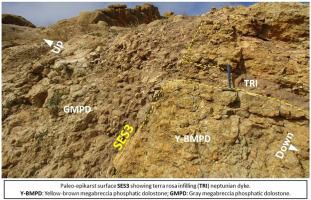Sedimentary breccias along a temporarily emergent Paleocene/Eocene carbonate ramp, Subatlas area of Marrakech, Morocco
IF 2.2
4区 地球科学
Q2 GEOSCIENCES, MULTIDISCIPLINARY
引用次数: 0
Abstract
The Subatlas zone of Marrakech (Morocco) provides a Paleocene-Eocene (P/E) sedimentary record outcropping in a NE-SW direction along the northern edge of the High Atlas. The present study reveals, for the first time, new sedimentological data across the P/E (Thanetian-Ypresian?) boundary. These data have remained unknown despite numerous studies conducted in this area. The P/E interval deposits belong to the Anmiter Formation, represented by bioclastic and fossiliferous limestones intercalated with claystones, silty-sandy marls, and phosphorites. Cherts, siliciclastic limestones, and dolostones occur sporadically. The deposits exhibit numerous sedimentary gaps, mainly corresponding to hardgrounds and subaerial exposure surfaces. The microfauna is scarce, consisting primarily of a few ostracods and benthic foraminifera. The distribution of litho-microfacies reflects deposition in marine environments ranging from proximal to relatively distal settings (inner to outer ramp). The breccias were formed through three main processes: (i) weathering in the vadose zone, (ii) intense erosion on elevated areas, and (iii) dissolution of rocks in an epikarst landscape. Megabreccia blocks and debris were likely emplaced through dissolution processes, exacerbated by significant fracturing resulting from tectonic instability under conditions of relative sea-level fall. These findings highlight the complex interaction of tectonic, climatic, and diagenetic factors during the Thanetian-Ypresian transition and provide new insights into the geological history of the Subatlas area. Further high-resolution studies, incorporating proxies such as stable isotopes and microfossil analyses, are necessary to refine the P/E boundary events in this area.

摩洛哥马拉喀什亚区古新世/始新世碳酸盐斜坡上的沉积角砾岩
马拉喀什(摩洛哥)亚地图带提供了沿高地图带北缘NE-SW方向的古新世-始新世(P/E)沉积记录。本研究首次揭示了跨P/E (Thanetian-Ypresian?)界线的新的沉积学资料。尽管在这一领域进行了大量研究,但这些数据仍然未知。P/E层段沉积属于Anmiter组,以生物碎屑和化石灰岩为代表,与粘土岩、粉砂泥灰岩和磷灰岩穿插。燧石、硅质灰岩和白云岩零星分布。矿床具有大量的沉积间隙,主要对应于硬地面和地面暴露面。微动物群稀少,主要由少数介形虫和底栖有孔虫组成。岩石微相的分布反映了从近端到相对远端(内斜坡到外斜坡)的海洋环境沉积。角砾岩的形成主要经历三个过程:(1)渗透带的风化作用;(2)高架地区的强烈侵蚀作用;(3)表溶岩景观中岩石的溶蚀作用。巨角砾岩块体和碎屑可能是通过溶蚀作用形成的,在相对海平面下降的条件下,由于构造不稳定而导致的严重破裂加剧了这一过程。这些发现突出了塔尼提-伊普雷斯过渡时期构造、气候和成岩因素的复杂相互作用,为亚特拉斯地区的地质历史提供了新的认识。进一步的高分辨率研究,结合稳定同位素和微化石分析等替代指标,有必要完善该地区的P/E边界事件。
本文章由计算机程序翻译,如有差异,请以英文原文为准。
求助全文
约1分钟内获得全文
求助全文
来源期刊

Journal of African Earth Sciences
地学-地球科学综合
CiteScore
4.70
自引率
4.30%
发文量
240
审稿时长
12 months
期刊介绍:
The Journal of African Earth Sciences sees itself as the prime geological journal for all aspects of the Earth Sciences about the African plate. Papers dealing with peripheral areas are welcome if they demonstrate a tight link with Africa.
The Journal publishes high quality, peer-reviewed scientific papers. It is devoted primarily to research papers but short communications relating to new developments of broad interest, reviews and book reviews will also be considered. Papers must have international appeal and should present work of more regional than local significance and dealing with well identified and justified scientific questions. Specialised technical papers, analytical or exploration reports must be avoided. Papers on applied geology should preferably be linked to such core disciplines and must be addressed to a more general geoscientific audience.
 求助内容:
求助内容: 应助结果提醒方式:
应助结果提醒方式:


